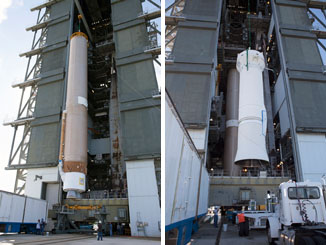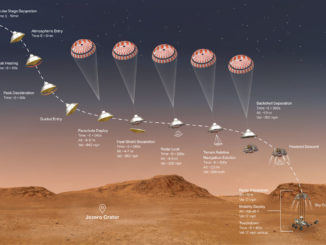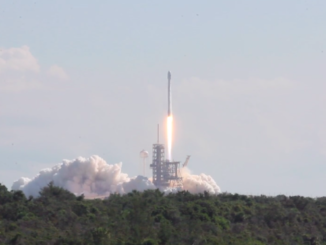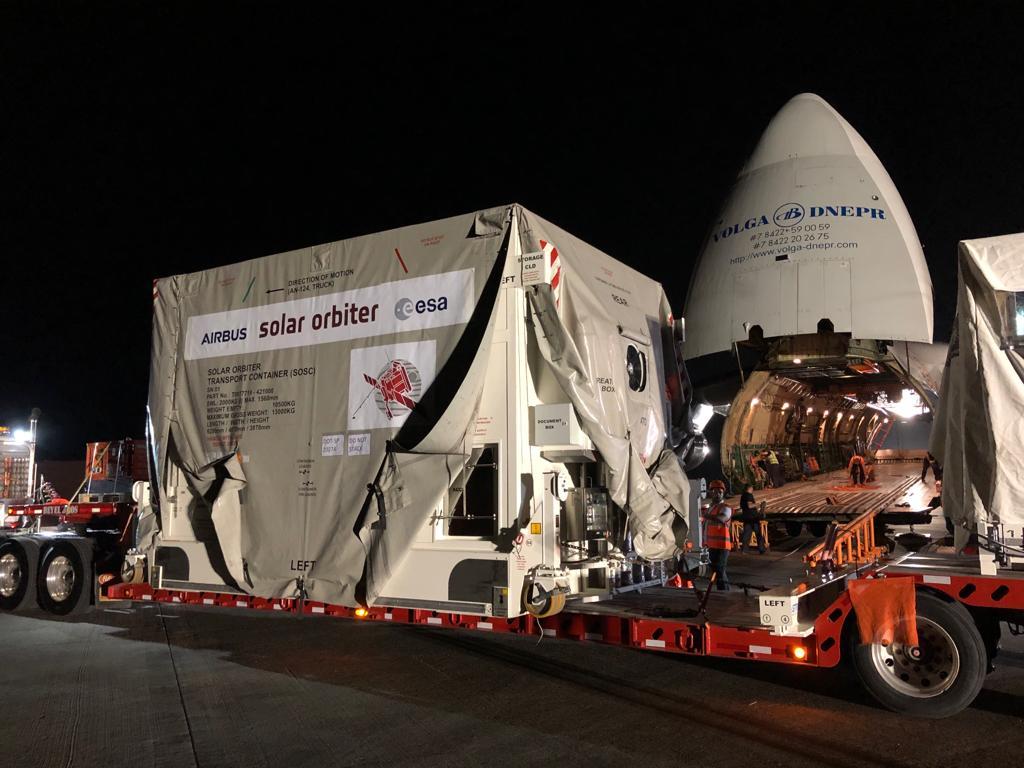
The European-built Solar Orbiter spacecraft arrived in Florida late Friday after a trans-Atlantic journey from a test center in Germany, ready to begin preparations for a liftoff from Cape Canaveral in February aboard a United Launch Alliance Atlas 5 rocket.
Packed inside a climate-controlled shipping container, the Solar Orbiter spacecraft rode an Antonov An-124 transport plane from Munich to the Shuttle Landing Facility at NASA’s Kennedy Space Center in Florida, where the aircraft touched down shortly after 9 p.m. EDT Friday (0100 GMT Saturday).
The spacecraft, built by Airbus Defense and Space, was expected to be transported by road to the Astrotech satellite processing facility in nearby Titusville, where ground teams will spend the next two-and-a-half months testing, fueling and readying Solar Orbiter for liftoff.
Ten scientific instruments aboard Solar Orbiter will measure the sun’s output and take the first detailed images of the sun’s poles. NASA is paying for the launch of the European Space Agency science probe as part of an international collaboration on the nearly $1.7 billion Solar Orbiter mission.
Scientists will use data from Solar Orbiter, in tandem with measurements from NASA’s Parker Solar Probe, to better understand what causes the solar wind, and what drives the 11-year solar cycle.
“Solar Orbiter is clearly a new class in its own,” said Günther Hasinger, director of ESA’s science program. “It has loads of instruments, which will go not as close as Parker Solar Probe, but quite close. Solar Orbiter will also have eyes. Parker Solar Probe can only sense and measure the plasma and the magnetic field, but Solar Orbiter also has six instruments that can really look at the sun, which is quite a challenge when you think it is reaching an environment where it’s about 600 degrees Celsius (1,100 degrees Fahrenheit). It’s like being in a pizza oven, so you have to make sure that you don’t burn the instruments.”
Parker Solar Probe, launched last year, faces much hotter conditions, where scorching temperatures would melt any camera exposed to the sun.
After launch, Solar Orbiter, or SolO, will use use gravitational assist flybys with Earth and Venus, placing the spacecraft in an orbit inside that of Mercury in 2022. Solar Orbiter’s final orbit will bring the spacecraft within 26 million miles (42 million kilometers) from the sun.
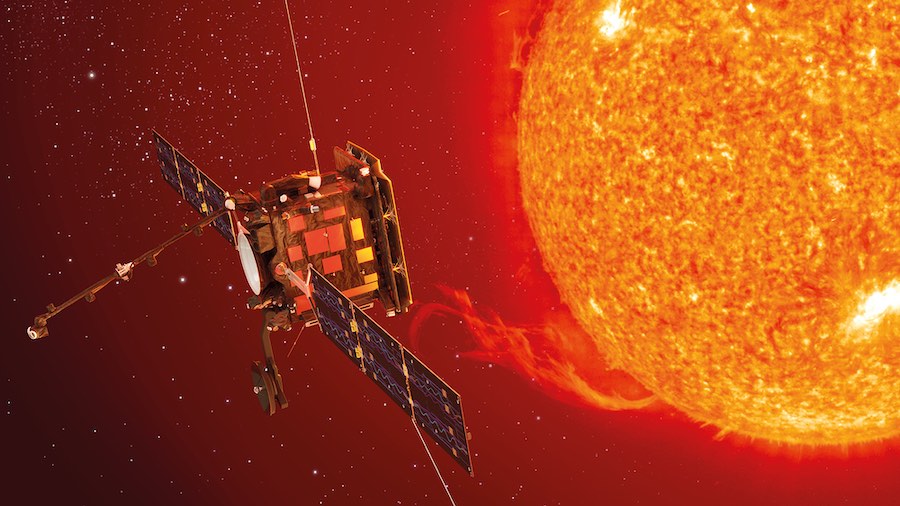
The planetary flybys will also use gravity to nudge Solar Orbiter into an inclined orbit around the sun, outside of the plane of the planets.
“One additional interesting element that has never been done before is that Solar Orbiter will be able to image the poles of the sun,” Hasinger said. “There are still mysteries around our understanding of the energy sources in the sun that produces the magnetic field and solar flares. A lot of people now think that some of the mysteries are actually hidden in the poles, which we have never seen.”
“Solar Orbiter is a science mission that will go close to the sun to take crucial measurements and try to find out how the heliosphere of the sun is operating, is working,” said César García, Solar Orbiter’s project manager at ESA. “To do that, it carries a series of instruments, actually 10 instruments. Some of them will be taking in situ measurements. They will be taking particles as they come off the sun.
“At the same time, they will be taking remote images and spectrographs of the sun’s surface, of the sun’s corona, and of the sun’s heliosphere to try and correlate what happens in those areas of the sun with the particles which are circulated,” García said.
United Launch Alliance plans to transport components of Solar Orbiter’s Atlas 5 rocket to Cape Canaveral later this month from the company’s factory in Decatur, Alabama.
Solar Orbiter will launch on a rarely-used configuration of the Atlas 5 known as the “411” version, with a single strap-on solid rocket booster on one side of the Atlas 5’s kerosene-fueled core stage.
Stacking of the Atlas 5 rocket for Solar Orbiter will begin Jan. 3 inside the Vertical Integration Facility at Cape Canaveral’s Complex 41 launch pad. A wet dress rehearsal, or fueling test, is planned Jan. 21 at pad 41.
Then Solar Orbiter will be added to the the top of the Atlas 5 rocket for a liftoff scheduled for 11:27 p.m. EST on Feb. 5 (0427 GMT on Feb. 6), the first of 19 daily launch opportunities in February.
If the launch does not occur in February, the mission’s next launch period opens in October 2020, when Earth and Venus are again in the proper position in the solar system to make Solar Orbiter’s interplanetary trajectory possible.
There is some concern among ESA and NASA teams that Solar Orbiter’s launch could be impacted by any further delays to a planned Dec. 17 Atlas 5 launch of Boeing’s Starliner commercial crew capsule on an unpiloted test flight to the International Space Station.
Both missions will use the same launch pad at Cape Canaveral.
The human-rated spaceship is one of two new commercial crew capsules NASA is funding — along with SpaceX’s Crew Dragon — to end U.S. reliance on Russian Soyuz ferry ships to carry astronauts to the International Space Station. Both new vehicles have faced delays, and NASA is eager to begin flying astronauts on U.S. spaceships for the first time since the retirement of the space shuttle in 2011.
Tim Dunn, NASA’s launch director for the Solar Orbiter mission, said last month the Solar Orbiter launch campaign could be impacted if the Starliner launch is delayed beyond around Dec. 27. The Starliner test flight is a major demonstration before the Boeing crew capsule is cleared to carry astronauts into orbit next year.
NASA has a role in both the Starliner and Solar Orbiter missions, and delays in the Boeing crew capsule test flight may force agency leaders to decide which mission will ultimately receive top priority in ULA’s launch manifest.
In addition to the high priority assigned to NASA’s commercial crew program, Solar Orbiter’s limited planetary launch opportunities, the spacecraft’s previous delays, and the international nature of the mission could also factor in to the agency’s decision.
Email the author.
Follow Stephen Clark on Twitter: @StephenClark1.

